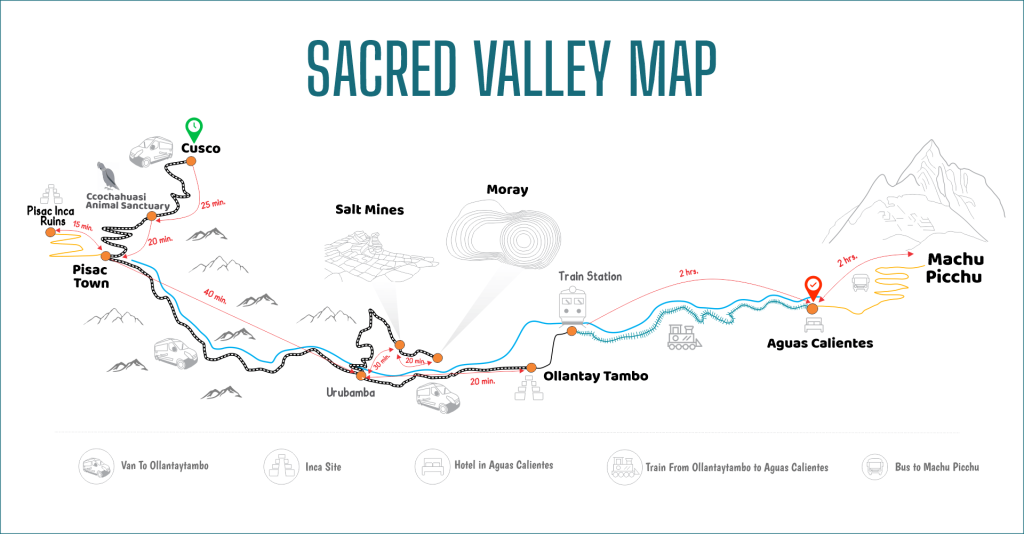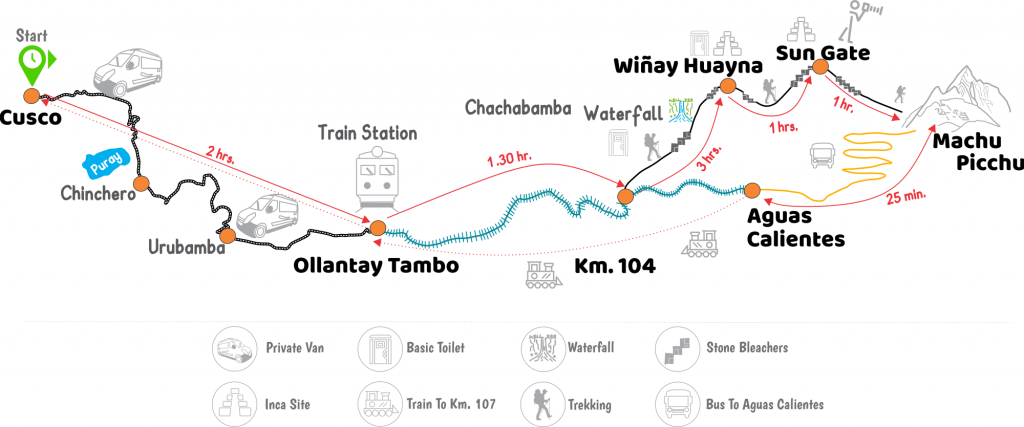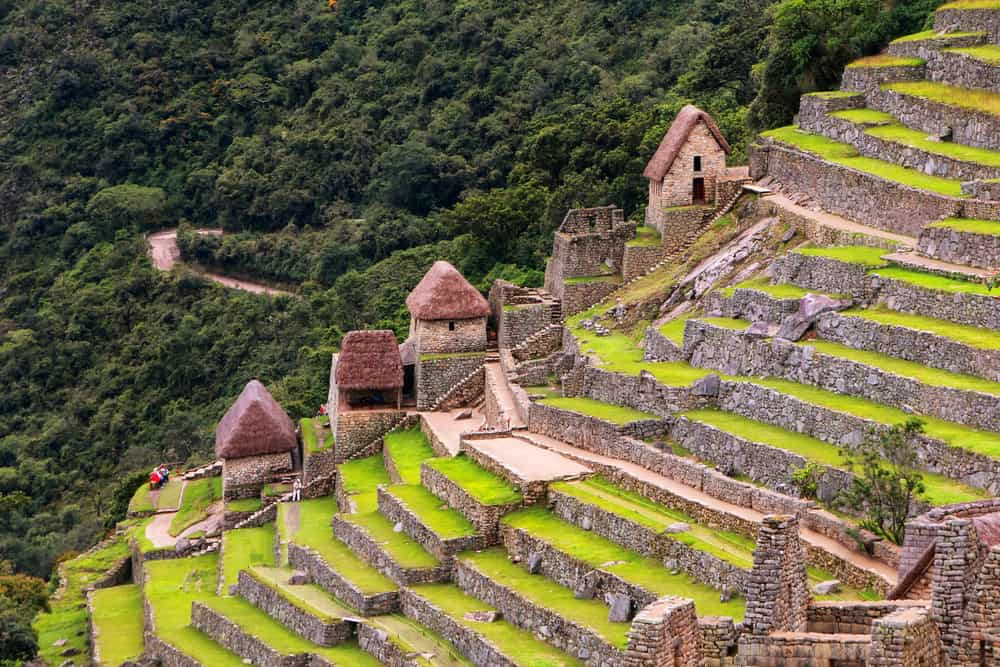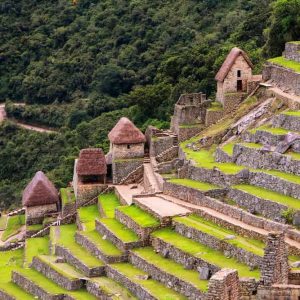The best Sacred Valley Tour itinerary inclusions.
Sacred Valley of the Incas Tour with Moray & the Salt Mines
The tour guide should pick you up at your hotel at 7:30am, with a private van and head towards the Sacred Valley of the Incas, where your adventrous and informative tour will begin!
Manos de la cominidada
Our first stop. Manos de la Comunidad has a variety of Cameloids indigenous to Peru like the llama, alpaca, guanacos and the Vicuna that produce very fine wool and can only be shorn every three years. We visit this farm to pet, feed and take pictures with these animals. Also, in the center are local women dressed in local garments, weaving items using the wool from the farm. As you exit, you will encounter a museum and souvenir shop. The workers are always around to answer any questions, but you should never feel pressured to buy anything.
Pisac
Most agencies stop first at the Mirador of Taray, where you get your first view of the valley. This spectacular view of the Urubamba valley is laid out before you, with traditional farming communities in the valley floor and mountain peaks rising from the end of the valley. Keep reading to see the places you’ll visit!
You will visit the extensive and well preserved Pisac archaeological site which overlooks the green lush valley and is the entry point. The Sacred Valley was agriculturally important to the Incas and still plays a major role in the sustenance of the Cusco region. Evidence of this can be found in the many food warehouses at the top of the hill, that were used for food preservation because of the lower temperatures.
The lower you go, you find carefully engineered large farming terraces, taking advantage of the different micro climates at each level. Also, present is an intricate water irrigation sytem originating from the stream uphill and supplying all the terraces below using water channels. Adjacent to the site is the biggest Inca cemetry found so far, with thousands of openings decorating the montain side. It is said that if you visit these tombs, you can still find human skeletal remains inside.
Salt mines
The Salt Mine (Salineras), close to the colonial town of Maras, are Pre-Inca. Hundreds of saltpans decorate the hillside and have been used for salt extraction since before the Inca era. A natural spring at the top of the valley discharges a small stream of water heavily laden with salt, which is diverted into saltpans and evaporated to produce a salt that is of very high quality. This is one of the few places in the world where you can find naturally pink salt! The locals have full mining rights and all the salt sold on site belongs to the locals. It still supplies Peru with over 90% of its salt.
The salt mines gives you a taste of an age-old tradition, that has not changed for many generations. The people in this community have been harvesting salt for many years. It’s a rich custom and tradition that has passed saltpans from one generation to the next. This has been their main source of income and they have exclusive rights to these mines. Salineras is one of the very few salt mines left in the world to have not switched to more modern techniques. The communal company of Maras (cooparative) packages and distributes the salt and splits the profits with the families according to the number of saltpans they own. This is a great place to grab a souvenir as all the money spent goes directly to the local community.
Moray
Moray was an experimental farming site built in the form of an ampitheater with different temperatures at each level in order to grow different types of crops. It is sometimes refered to as the “Greenhouse of the Incas” because it functioned the same way a modern greenhouse would function. These levels of terraces were carved before the Incas took control of the Sacred Valley and then used by them to research optimal growing conditions for their crops. They even brought in different soil samples from other regions, to optimise their research. The locals were still using it for growing their crops, until the 1970s when it was preserved and protected for tourism
Ollantaytambo
Finally, we drive to Ollantaytambo to explore this quaint Inca village and the amazing Inca Ruins on the hilltop above. These ruins are where the Incas fought their last battle with the Spanish conquerous, before they had to retreat and flee into the dense jungle. Most of the structures were unfortunately incomplete. There is a section with a number of boulders that were carved, but sadly were forced to be left where they lie to this day.
Another possibility, is that the battle was so intense, it caused a lot of damage to this massive Inca site. Still standing is the incredible architecture of the Sun Temple, where we can admire the intricate water fountains, the Incahuatana and the impressive storehouses. It is believed the site initially belonged to Aymaru clan, before being taken over by the Incas. It stands as the last and best fought battle between the Incas and the Spanish. While the Incas won this battle, they were forced to retreat becuase their numbers were being depleted by the thousands due to the spanish flu. Most tours end here and from the top of the site, you can watch the sunset over the town and the calming river on your right.
Ollantaytambo holds many annual festivals, the biggest taking place in January, around Epiphany (5th January to 9th January) and Pentecost (May or June). Check online if there is anything coming up during your stay. Its a great tourist hub, with an assortment of restaurants and accomodation establishments for all budgets. It’s the gateway to the Inca Trail or to get on the train to Machu Picchu.

Day 2: We depart Ollantaytambo by train for the 1 day Inca Trail
At 5:30am we depart our hotel, to catch the train in Ollantaytambo.
At 6:10am we take the train to Km 104 following the Urubamba River until we reach our destination, where we’ll begin our trek and along the way you’ll see spectacular views of farmlands, snow-capped mountains and the mighty Urubamba River. The Urubamba River is one of the sources of the massive Amazon River and is a very impressive sight.
By 7:40 am at KM 104 (2,000 m), we’ll begin our breathtaking trek, then we’ll set off to visit our first Inca site. You will get a short orientation about this historical Inca site as well as a walking tour. Then we’ll begin hiking as we head for the Classic Inca Trail. We’ll have tremendous views of Machu Picchu, the Urubamba River and other surrounding Inca Sites.
By 11am; After hiking for three hours we’ll reach the one of the most beautiful Incan site on the Inca Trail; Wiñay Wayna (Forever Young) at 2,600m/8,500ft. Few people get the opportunity to see these elaborate water fountains, temples and agricultural terraces. These provide a perfect opportunity to learn about the history of the Incas. The backdrop of this site is a dramatic cliff drop with beautiful mountains surrounding the area.
By 12:00pm; from Wiñay Wayna, we will walk to the Sun Gate, from which you have your first view of Machu Picchu! Though the hour long walk is a gentle rolling up and down, it does end with a set of steep stairs carved directly into the bedrock by the Inca. Once you reach the stairs you will know that you’re almost at the Sun Gate! It is a breathtaking view of Machu Picchu, so take some time to savor the moment and take lots of photos.
By 1:00pm, We start hiking the last 45 minutes down to Machu Picchu, having many opportunities to take more photos of Machu Picchu from this unique vantage point. There are also a couple more important Inca sites between the Sun Gate and Machu Picchu, so make sure to go slowly, and enjoy your time walking in the footsteps of the Inca. Do not be afraid to ask your guide questions about these historical places on the last bit of your hike to Machu Picchu.
By 2:00pm; Your guide will give you the full tour of the citadel, which usually takes about two hours. You will see all of the most important parts of Machu Picchu. You will also learn about how Machu Picchu is divided into three sectors: agricultural, residential and religious.
Take your time to enjoy this magical experience before you take the bus down to Aguas Calientes.
By 4:30pm, you will then take the 25m bus ride to Aguas Calientes.
At 6:20pm, you will take the return Expedition train to Ollantaytambo and catch our private van to Cusco and your hotel.
By 22h, you arrive back at your hotel in Cusco
Please Note: all times are estimates and can be affected by a number of different factors

Packing Check List for the 1 day Inca Trail to Machu Picchu
- Original passport (it has to be the same as the one you have used for booking your trek)
- Good daypack (20-30 liters is recommended), It will be carried by yourself – No porters available on this day hike.
- Reusable water bottle (in an effort to reduce plastic waste, disposable bottles are not allowed)
- Comfortable hiking boots with ankle support
- Toilet paper
- Windbreaker or warm jacket
- Layers, so you can take off warm clothes when hiking and bundle up upon reaching the top
- Hand sanitizer
- Wet wipes
- Personal medications
- Sun hat, wool wat (only in the cold season) and sunscreen
- Rain gear (if rainy season)
- Snacks like chocolate bars, cereal bars or any dry fruits
- Insect Repellent
- Rain plastic poncho
- Camera
- Extra money for souvenirs and tips
Why hike the ONE day Inca Trail to Machu Picchu?
- Hike the last 1/3 of the famous Classic Inca Trail, that is on bucket lists worldwide.
- Explore Wiñay Wayna, an amazing and unique Inca archeological site that not many get to see.
- Trek the actual trail that the Ancient Incas hiked more than 600 years ago.
- Hike through the Sun Gate (Inti Punku) all the way to the famous Machu Picchu Citadel.
- Experience the spectacular views of Machu Picchu from the Sun Gate.
- Visit Machu Picchu Citadel in the late afternoon when it is less crowded.
Important
It is very important for potential trekkers of the 1 Day Inca Trail to understand that you are doing the same trail as the 2 Day Inca Trail, just quicker. Trekkers need to be in moderate to good physical condition to be able to do this trek and arrive at Machu Picchu Citadel on time. If you think the trek may be too strenuous, you may book the 2 day Inca Trail which arrives in Machu Picchu at a much slower pace, and later in the day.
The weather on the Inca trail to Machu Picchu
On the Inca Trail, the weather depends on whether it is the rainy season or the dry season. The 1 day Inca Trail (Section) is at lower altitude than Cusco, by about 1,000 meters or about 3,000 feet lower. Thus it tends to be a bit warmer during the day and at night.
However, it is more tropical and more humid than Cusco. There is always a chance of rain showers, especially in the cloud forest areas. In the rainy season, these showers will last longer and be much more intense tropical rain showers. The Inca Trail is made of stones laid in the ground so it can be more slippery to walk on in the rainy season.
One day Inca Trail safety tips
- Most of the trek is uphill and with a fair number of precipices, steep cliffs, tons of steps (up & downs), and its humid. A good physical condition is required.
- Tour operators must be licensed, there is NO WAY to do this hike by yourself, see below for recommended operators
- It is very important for potential trekkers of the 1 Day Inca Trail to understand that you are doing the same trail as the 2 Day Inca Trail, just more quickly. Trekkers need to be in moderate to excellent physical condition to be able to do this trek and arrive at Machu Picchu Citadel on time.
- The Hike covers 12km/ 8 miles which can be done in about 5 hours
Frequently Asked Questions
How difficult its the one day Inca Trail?
It is very important for potential trekkers for the 1 Day Inca Trail to understand that you are doing the same trail as the 2 Day Inca Trail, just more quickly. Trekkers need to be in moderate to excellent physical condition to be able to do this trek and arrive at Machu Picchu Citadel in time. If you think the trek may be too strenuous, you may book the 2 day Inca Trail which arrives to Machu Picchu in one day but at a slower pace later in the day.
Where is the starting point of the hike?
The actual hike starts at KM 104, from this point it takes 12km to reach Machu Picchu.
Do I need permits for this hike?
YES, Government issued permits are required and can only be acquired from a licensed tour operator like Orange Nation.
There are only 250 permits per day for the Short Inca Trail. All visitors and professional crew need a permit. Tickets do sell out fast (Peak season sells out within days) We recommend booking far in advance and as soon as there’s availability for your preferred dates.
How long does it take from Km 104 to Machu Picchu City?
It takes around 5 to 6 hours, depending on your fitness level, it covers 12km in total.
What about the altitude?
Machu Picchu is 2,430 meters (7,972 feet) above sea level, which is much lower than the city of Cusco — 3,400 meters or 11,152 feet — so it’s likely you won’t suffer from altitude sickness if you’ve already spent time acclimatizing in Cusco first. But if you hike the 1 day Inca Trail it is about 2,700 meters (8,858 feet) above sea level, so you may feel it, especially if you’re being active. If you’re concerned about altitude, take it slow and drink plenty of water. Sipping coca tea, chewing coca leaves or taking a soroche pill can also help.
What is the best time to visit Machu Picchu?
Consider visiting Machu Picchu from April through May and from September through October. The high-tourist season months are June, July and August when it doesn’t rain.
When was Machu Picchu discovered?
Machu Picchu wasn’t exactly “discovered” because local people have always known about its existence. In 1911, the American explorer Hiram Bingham made public his findings and -wrongly- called it “The Lost City of the Incas”.
Nine years before Bingham had arrived, the Peruvian Agustin Lizárraga had found the ruins and left his signature on one of the walls of the Three Windows Temple in the Citadel. However, upon Bingham’s arrival he removed the mark in order to take glory.
*** The ONE day Inca Trail Information has been updated in June 2023!
Recommended Tour Operators for the Sacred Valley
SAM Travel Peru
SAM Travel Peru (10 years in business) is a highly professional tour & trekking company that focuses on treks and tours for travelers of all ages, making sure everyone has the best possible experience. A key feature offered by SAM Travel is small group sizes and personalized service. They never exceed ten trekkers per group, unlike many operators who will happily reach the maximum group limit of 16 or more people. They work with each group to personalize their tour if needed. One size does not fit all. What’s more, the company’s Peruvian owner, Saul Alvarez, has been working along the Inca Trail since the age of 18, as a porter and later as a guide. He understands trekking better than most and the needs of the hiker. Please check all of its great reviews on TripAdvisor.
Website: https://www.samtravelperu.com/

Orange Nation Peru
For a while, this relatively new start-up company has been on my list of Inca Trail tour operators to consider. The company focuses on quality treks and tours for those that are budget conscious. The company tour guides, porters and cooks have shares in the company, and earn a fair amount for their level of contributions. When you choose this company, you make a direct impact to all the lives of the people that make your adventure memorable. The company has also has plenty of excellent reviews on TripAdvisor. This is definitely, one to consider.
Website: https://www.orange-nation.com

Spider Travel Peru
Spider Travel Peru is a new innovative professional adventure travel company and Inca Trail Operator that offers unparalleled experiences to unknown and untouched wilderness areas. Spider has adventure treks that are carefully designed to cater to all of the possible options its clients might desire. Its passions are sharing the incredible landscapes of the Andes and the history and culture of the Inca people! Make sure you consider its many options!
Website: https://www.spidertravelperu.com/

Glamping Peru Treks
Glamping Peru Treks creates treks and tours that offer unsurpassed luxury and comfort while hiking off the beaten track. All accommodations, food, and services are of the highest quality and standards. If you are looking for something upscale and luxurious while trekking or touring, this is the absolute best option for you. Do not be afraid to work with their service operators to create your dream personalized luxury trek or tour. The company group size averages 2 to 4 people, not exceeding 8 people. If you love your privacy, be sure to ask for a private tour.
Website: https://www.glampingperutreks.com/




